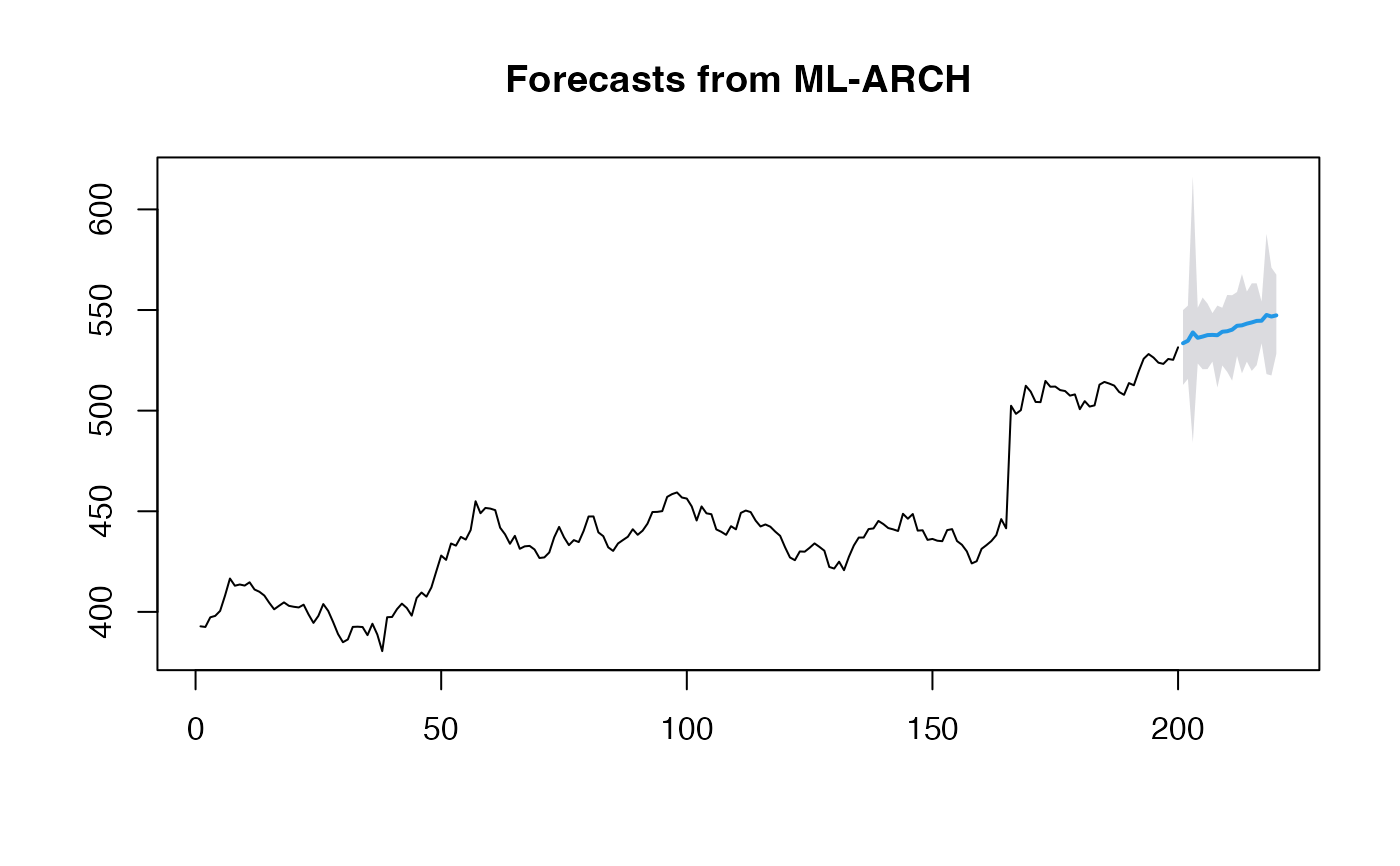Conformalized Forecasting using Machine Learning (and statistical) models with ARCH effects
mlarchf.RdConformalized Forecasting using Machine Learning (and statistical) models with ARCH effects
mlarchf(
y,
h = 10L,
mean_model = forecast::auto.arima,
model_residuals = forecast::meanf,
fit_func = ahead::ridge,
predict_func = predict,
lags_vol = 10L,
type_pi = c("surrogate", "bootstrap", "kde"),
type_sim_conformalize = c("surrogate", "block-bootstrap", "bootstrap", "kde",
"fitdistr"),
ml_method = NULL,
level = 95,
B = 250L,
ml = TRUE,
stat_model = NULL,
n_clusters = 0,
clustering_dist = "euclidean",
clustering_method = "kmeans",
...
)Arguments
- y
A numeric vector or time series of class
ts- h
Forecasting horizon
- mean_model
Function to fit the mean model (default:
forecast::auto.arima)- model_residuals
Function to model the residuals (default:
forecast::thetaf)- fit_func
Fitting function for the variance model (default:
ahead::ridge)- predict_func
Prediction function for the variance model (default:
predict)- lags_vol
Number of lags for squared residuals regression
- type_pi
Type of prediction interval ("kde", "surrogate", or "bootstrap") for volatility modeling
- type_sim_conformalize
Type of simulation for conformalization of standardized residuals ("block-bootstrap", "surrogate", "kde", "bootstrap", or "fitdistr")
- ml_method
caret package Machine learning method to use, if
fit_funcandpredict_funcaren't provided. If NULL, usesfit_funcandpredict_func. Seeunique(caret::modelLookup()$model).- level
Confidence level for prediction intervals
- B
Number of bootstrap replications or simulations
- ml
If
TRUE,fit_funcandpredict_funcare used, otherwise a statistical model instat_model- stat_model
A statistical model, e.g
forecast::thetaforforecast::auto.arima- n_clusters
Number of clusters for residuals (default is 0) for
ml == TRUEandml_methodnotNULL- clustering_dist
Only if
n_clusters > 0. If "euclidean", then mean square error, if "manhattan ", the mean absolute error is used.- clustering_method
Only if
n_clusters > 0. If "kmeans", then we have the kmeans clustering method, if "hardcl" we have the On-line Update (Hard Competitive learning) method, and if "neuralgas", we have the Neural Gas (Soft Competitive learning) method. Abbreviations of the method names are accepted.- ...
Additional parameters to be passed to
stat_model
Value
A forecast object containing predictions and prediction intervals
Examples
y <- fpp2::goog200
# Default model for volatility (Ridge regression for volatility)
(obj_ridge <- ahead::mlarchf(y, h=20L, B=500L))
#> Point Forecast Lo 95 Hi 95
#> 201 533.4806 512.7812 549.9381
#> 202 534.7064 515.7697 552.1797
#> 203 538.8649 484.1721 616.3803
#> 204 536.1930 523.4435 551.1034
#> 205 536.8055 520.5741 556.1976
#> 206 537.5393 520.6689 553.1701
#> 207 537.6365 524.3945 548.4499
#> 208 537.4759 511.4850 552.1990
#> 209 539.1986 522.4345 551.1335
#> 210 539.4604 519.2788 557.4779
#> 211 540.2246 514.9235 557.3380
#> 212 542.1635 527.1610 558.9331
#> 213 542.3887 518.5475 567.8483
#> 214 543.2326 524.3450 559.1676
#> 215 543.8326 519.7481 563.2478
#> 216 544.5939 522.5941 563.2784
#> 217 544.6853 533.4650 554.1662
#> 218 547.5403 518.1748 587.8554
#> 219 546.7615 517.4711 571.0961
#> 220 547.3477 528.1812 567.5666
plot(obj_ridge)
